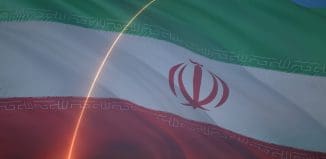Yes to an Agreement that, even if Violated, Distances Iran from the Bomb
This post is also available in:  עברית (Hebrew)
עברית (Hebrew)
By Amos Yadlin
 The final weekend of September 2013 saw the Iranian charm school at work in full force, with a campaign comprising every component of a sophisticated public diplomacy strategy: moderate advance articles in leading newspapers signed by past and present Iranian presidents; TV interviews at the leading networks with senior female journalists (with the hijab and without); background discussions with senior analysts; non-belligerent speeches at the United Nations that said “the right things” and avoided the extreme rhetoric typical of Iran’s most recent former president; meetings of foreign ministers that were a thing of the past; and – on the way to JFK Airport – an historic telephone conversation between the Iranian and US presidents.
The final weekend of September 2013 saw the Iranian charm school at work in full force, with a campaign comprising every component of a sophisticated public diplomacy strategy: moderate advance articles in leading newspapers signed by past and present Iranian presidents; TV interviews at the leading networks with senior female journalists (with the hijab and without); background discussions with senior analysts; non-belligerent speeches at the United Nations that said “the right things” and avoided the extreme rhetoric typical of Iran’s most recent former president; meetings of foreign ministers that were a thing of the past; and – on the way to JFK Airport – an historic telephone conversation between the Iranian and US presidents.
Israeli Prime Minister Benjamin Netanyahu, who flew to the US for talks with President Obama and a speech at the UN General Assembly, faces a tough mission: on the one hand, not to paint himself into a corner and become the obstacle to an agreement, i.e., the party that is oblivious to the changes in the international arena and is unwavering in pursuit of an aggressive alternative. On the other hand, he must present a unified, well-reasoned argument that will answer the question of “now what.” What is the proper course of action from this point onward? What is a good agreement that can credibly neutralize the danger of an Iranian bomb, and what is a bad agreement that will allow Iran to attain a possibility to dash to a nuclear bomb?
Israel pressed long and hard for harsh sanctions: now that the sanctions have proven themselves as an effective tool for a possible agreement, Israel should not regret the option of solving the crisis by an agreement. Now the focus must be on the contents of the agreement rather than the process. It is unclear what lies behind Rouhani’s drive to reach an agreement on the nuclear problem in a few months, or Khamenei’s affirmation of the need for “heroic flexibility.” Do these signal a willingness to forfeit a military nuclear capability, or yet another attempt to attain this option at the lowest possible cost? For its part, Israel must guarantee that a diplomatic deal is sound enough, and ensure that diplomacy yields more than just a respite for Iran as its nuclear project progresses.
What follows are ten points for consideration by the Prime Minister in his discussion with President Obama and his speech at the UN.
1. A positive rather than a negative attitude: Dialogue and negotiations are important, legitimate tools. A stance that takes a positive view of diplomatic solutions should be adopted, as these are always preferable to military measures. Nonetheless, dialogue is not the ultimate goal, and it must serve only as the setting for a process that neutralizes the Iranian military nuclear threat. The Prime Minister must insist on the contents of the agreement and its details, because the devil is in the details. Israel must be familiar with these details and relay its position regarding these details in unequivocal fashion.
2. Iran may well reject the Prime Minister’s demands (zero enrichment, removal of all the enriched material from Iran, the suspension of activity at the underground facility in Fordow and the reactor at Arak). Nonetheless it is important to define an agreement that even if containing a certain risk that Iran could break out to military nuclear capability either under or in violation of the deal, still represents a significantly smaller threat than the dangers inherent in the status quo, which is likely leading to an Iranian bomb or to a military move to forestall it.
3. Anyone examining the statements made by the US and Iranian Presidents could justifiably assume that there was prior coordination in the terms used about the principles of an expected agreement: on the one hand, Iran’s right to develop sources of nuclear energy, and on the other hand, transparency and verification as well as “significant steps” that have not been specified by either side. The Prime Minister must underscore that verification and transparency, while all well and good as long as the agreement is in effect, are of themselves insufficient. It must be assumed that the agreement could be unilaterally abrogated by Iran, similar to the agreement on the freeze of the Iranian nuclear program that Hassan Rouhani, then head negotiator with Europe, concluded in 2003. In case of a future violation of the agreement, it is incumbent upon Israel to make sure that the Iranians are years rather than months away from a nuclear bomb. It is also important to agree with President Obama on the West’s response to a future Iranian violation of the agreement.
4. The United States and Israel must concentrate on the parameters that widen the distance between Iran and the bomb should Iran unilaterally abrogate the agreement, expel the inspectors, withdraw from the Non-Proliferation Treaty, or operate covertly yet again. This would entail a strict limit on the number of centrifuges spinning in Iran, enrichment limited to 3.5 percent, removal of all enriched material from Iran, and return of enriched material to Iran only in a form that cannot be used in nuclear bombs. It is important that the verification occur as stipulated by the Additional Protocol, including the right to search for covert sites where the Iranians are violating the agreement. At the same time, it is necessary to ensure that the Fordow enrichment facility and the Arak nuclear reactor cannot serve as a springboard to the bomb should Iran declare the agreement null and void.
5. An agreement that freezes Iran’s program at its current extent – more than 10,000 active old centrifuges, thousands of more modern centrifuges with a higher output, and material that if enriched to a military level will be enough for seven to nine bombs – is a bad agreement and is unacceptable. A freeze at this level and a functional Fordow are an excellent foundation for a bomb at any time Iran decides to withdraw from the agreement. The agreement must also include monitoring of Iranian activity regarding development of a warhead for a nuclear bomb. Iran has never cleared itself of the suspicions raised by the International Atomic Energy Agency as far back as 2002. It has not provided explanations for various activities over the last two decades linked to the weapons project, suspicious sites, and individuals. It has blocked access to these elements, rendering a resolution of the suspicions impossible. Indeed, this was another reason the Iranian case was transferred from the IAEA to the Security Council.
iHLS – Israel Homeland Security
6. The risks inherent in the negotiations process itself: it is essential that the process have a predetermined final date. Iran is liable to resort once again to delay tactics to buy time to advance its nuclear project in every way: manufacturing and operating more centrifuges to enrich uranium, amassing enriched nuclear material, developing a plutonium-based option, and making progress on a nuclear warhead. The Iranians are master negotiators; their counterparts must be just as artful as they. Despite all the moderation on display, the Iranians have not conceded a thing: experts at taking without giving, they have repeated their traditional positions, albeit with less inciting rhetoric. Iran’s demand that “the Iranian file” be closed must be rejected.
7. The one-dimensional red line mistake should not be repeated. The worst deal for the West is one in which only a single dimension, e.g., the enrichment level, is dealt with. That which seems attractive to many Western experts – an “achievement” that would limit Iranian enrichment to 5 percent or ensure that Prime Minister Netanyahu’s red line of 2012 is not crossed (material for one bomb enriched to 20 percent) – is a dangerous, unsatisfactory attempt to deal with a single dimension of the Iranian nuclear program. Any future deal must also deal with equally important complementary dimensions: the number of centrifuges, the amount of low-level enriched material, and the plutonium track.
8. Small confidence building measures should be avoided, and it is wiser to proceed directly to the endgame. Perhaps the only reason for the Iranians’ more conciliatory posture is the heavy weight of the sanctions. The Iranians are looking for significant relief from the sanctions in exchange for a non-significant confidence building measure. However, the confidence building route has failed repeatedly over the last decade of negotiations with the Iranians. It can be agreed at the first stage of the negotiations that the sanctions will be lifted, but only as a “deposit” of sorts, i.e., a promise to be fulfilled once Iran has and actually executed what it has committed itself to do, namely, reduce the scope of the program.
9. The Syrian model is a positive example: the complete dismantlement of the full production complex of all nonconventional weapons capabilities and their removal from Syria, extensive supervision backed by a Security Council resolution, and a maintained credible threat of military force. Even in Syria, however, the test lies in the future execution of the agreement and Assad’s full cooperation. President Obama’s statements should be supported, specifically, that the case of Iran and nuclear weapons is far more serious than the case of Syria, and that the threat from Iran to world peace, US interests, the Gulf states, and of course Israel is far greater.
10. Finally, even if the nuclear problem is the central problem in the Middle East, it is not the only challenge Iran poses to regional peace and stability. The peace process, which President Obama has declared to be no less an issue, has been the target of heinous terrorist acts carried out by Iranian proxy organizations that have been major contributors to obstruction of the process for the past 20 years. Iran’s highly negative role in Syria, where it is a full partner to the widespread massacres, and its negative impact in Lebanon, the Gulf, and Iraq must also be discussed in the renewal of the dialogue between the United States and Iran.
A (good) agreement must be given a chance, even if it seems that the Iranian move is an exercise in deceit. Exposing the deceit can yield strategic benefits. Negotiations between the United States and Iran could go in three directions, two of which could be positive for Israel: a good agreement that would keep Iran far from the bomb, or a resounding failure that would grant legitimacy to other actions designed to stop the project. The challenge facing Prime Minister Netanyahu is to prevent a bad agreement and reach an understanding with the United States on the questions of process and essence: what sort of negotiations process and what sort of deal would be detrimental for America’s and Israel’s vital interests. It is important to understand, influence, and if possible reach a conclusion on what America’s policy will be if the negotiations fail or the agreement is violated in the future, and how effective levers of influence on Iran – sanctions and a credible military option – can be preserved, as only they are capable of changing the Iranian behavior.
INSS Insight No. 469, September 29, 2013





























